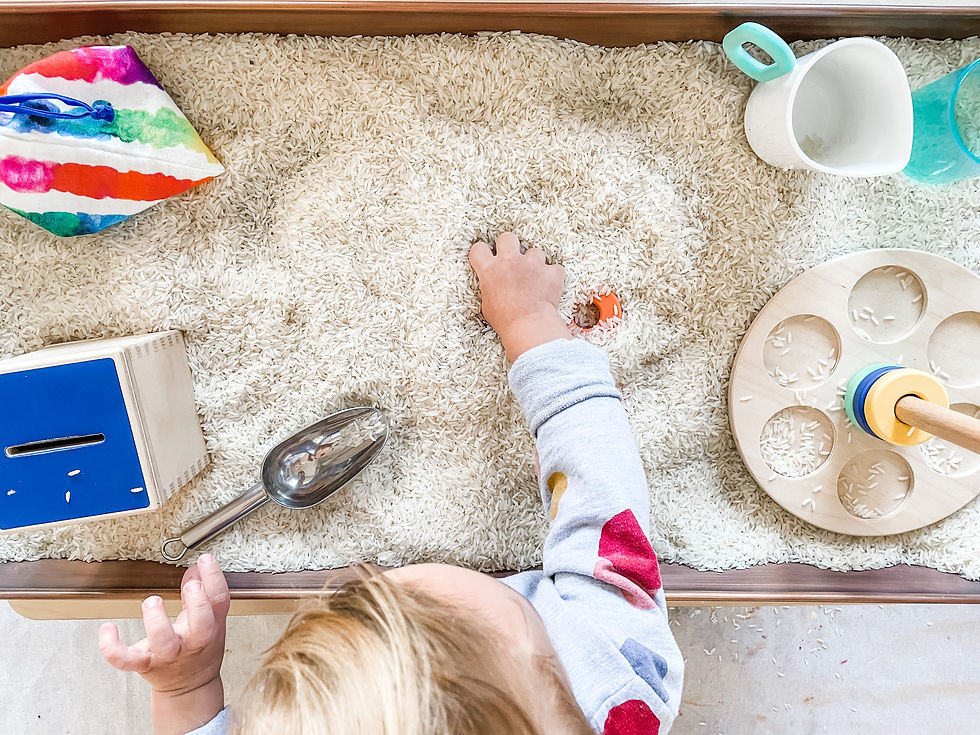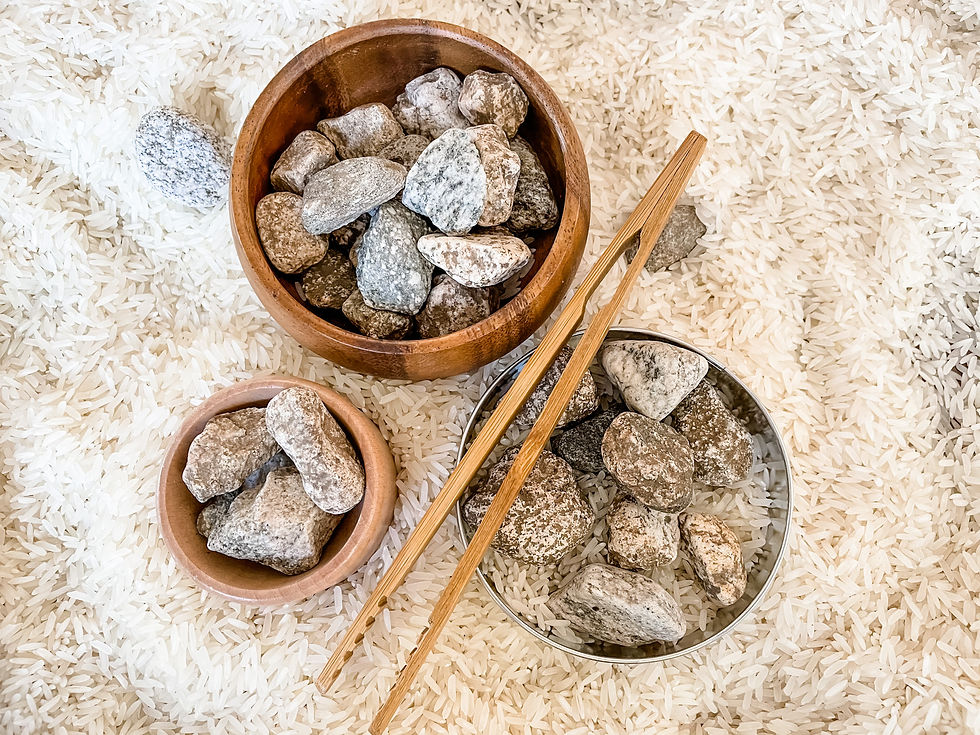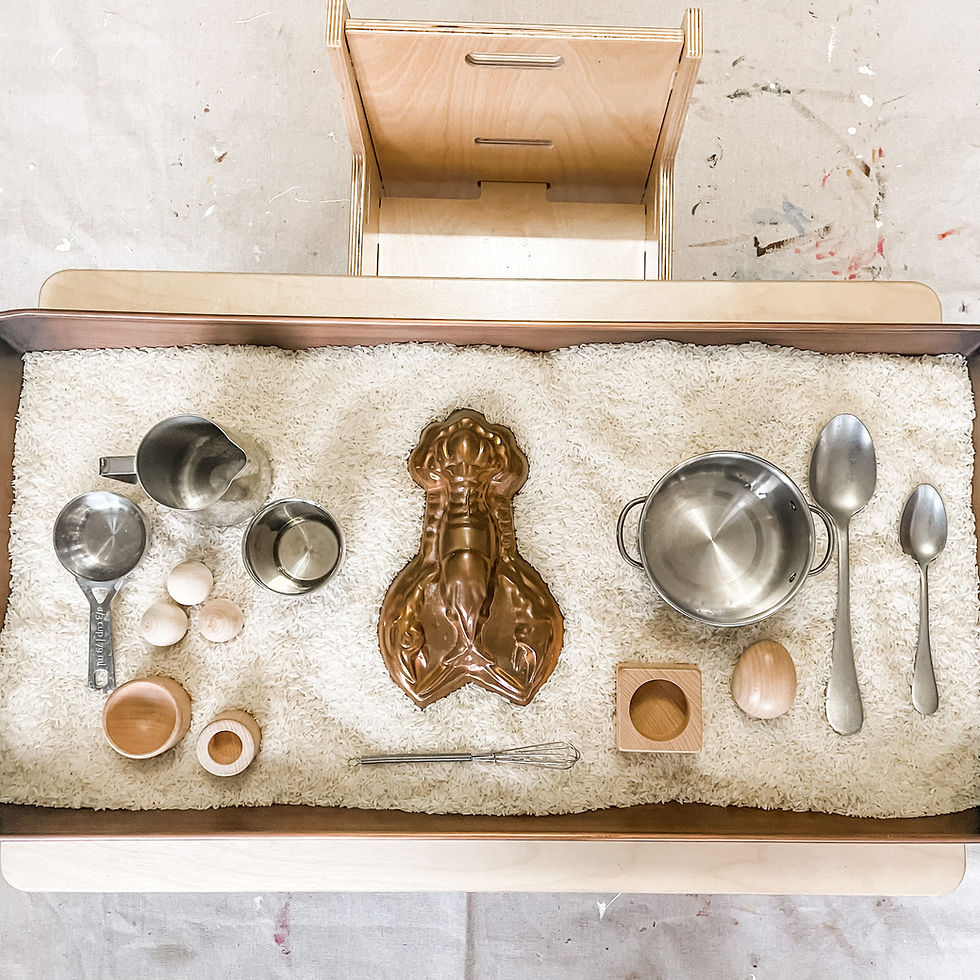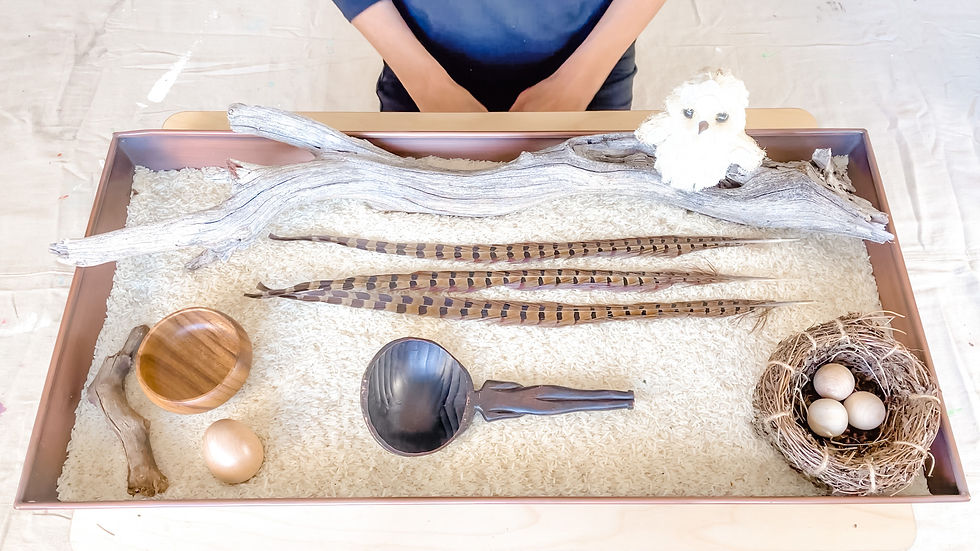
To me, there are two distinct categories of sensory bins. I am here for them both.
I call the first category of bins, “easy bins” because they’re an easy win. Throw into a bin some beans, shovels, bowls, a few fun items, and voilà, you’ve got a bin that will keep a toddler engaged for quite some time. The whole point of these bins is to maximize learning and fun, while minimizing set up.
There are tons of articles out there about how to create quick, inexpensive, and effective sensory bins. Busy Toddler does a nice job of walking you through a basic set up, and The Chaos and the Clutter has a thorough list of fillers and tools as you venture into slightly deeper waters. But keep swimming and you’ll eventually hit the deep end of the pool. That’s where we’re heading.
The second type of bin takes a bit more effort. I’ll call these the extra bins, cause honestly, they’re a bit extra. Extra effort, extra thought, extra learning. Extra. And while they may not be everybody’s cup of tea, they have earned a top spot in our household.

We’re talking about themed bins, or bins that are specifically designed to extend learning around a topic or book. I’m also including in here sensory bins so visually appealing, they are essentially interactive works of art. These are the Instagram/Pinterest dream bins that stop you in your tracks and make you want to start playing yourself.
When I started creating sensory bins for Rémy, I did a deep dive into those bins. I looked at way too many pictures, and did my best to analyze what was going on. Why on Earth devote that much time evaluating sensory bins? Well first, that’s what learning nerds do, and second, I knew I needed to understand what makes those bins tick if I was going to get creative with Rémy’s.
So I’m going to share with you what I learned, and how I started really planning out and creating bins that are extra. Here you can see five of these bins in action:
But First...
Let’s just take a second to remind ourselves why sensory bins have earned their distinguished place in toddler play. Working in a bin promotes language development, problem solving skills, fine and gross motor skills, and can give toddlers a social and emotional workout. And while these are truly outstanding benefits, you could probably figure out a way to meet these same learning needs elsewhere.
The big payoff comes from sensory integration. Every toddler’s brain is working hard to figure out how to organize the sensory information that they encounter, and then make behavioral choices based on that information. Children with sensory processing disorders struggle with this process and need to work extra hard at learning how to make sense of what’s coming through.

All toddlers, however, require enough sensory experiences during their critical early years to be able to build up their cognitive abilities. And that is where sensory play comes in. By giving your toddler the opportunity to play with all of their senses, you are ensuring that you are meeting their growing brain’s needs.
Why Be Extra?
Being a parent means that you are strapped for time. I am no exception. I am constantly making mental calculations about the value of an activity vs. the time it takes for me to set it up. Because these bins take quite a bit of time, they better pay off in a big way. They do.
I make each of the bins available for as long as Rémy shows interest. When not in use, the bin sits on a table waiting. If he is interested in playing with it, he comes to the table and points to it. This happens once a day for at least a week.
Each time he plays with the bin, he focuses on it for 30-45 minutes. That in and of itself is amazing for a 19 month old, and is worth the effort I’m putting in. But if you do the calculations, one rotation with a bin will see at least 3 ½ hours of play. That’s more than any other activity Rémy does throughout the week except for dirt play (which is the granddaddy of all sensory play).
Once he’s done with a bin, I put together a new one, but that doesn’t mean that the old one disappears for good. It is out of rotation, but it's time will come again. Which means even more play time. So in the end, a single bin that took me an hour to think about, collect items for, and put together, will provide my son countless hours of learning and fun. Well worth it.

Of course there are all the learning moments that are tucked away into those hours. Because I’ve taken the time to nestle in activities that strengthen skills and ideas that we are working on, I don’t have to create other activities or practices. I actually pick up time and energy by creating one bin to teach multiple ideas.
Dissecting the Bins
Take a closer look at these amazing bins and you’ll find the same skeleton. All bins have the same three basic components:
The physical bin which houses everything
The filler or base which fills up the bin and provides something to touch and transfer around
The tools, manipulatives, and interactives which children use to engage with the filler, build, transfer, and world build
The most high end, show-stopping sensory bin and one thrown together in five minutes have these same components. What set apart the extra bins? I found 5 key elements that were distinguishing. So if I was to create a truly amazing bin, I needed to put extra thought into:
1. The materials used
There’s no getting around it, if you want to create a bin that is an interactive work of art, then you’re going to have to use materials that have some sense of beauty to them. They are the type of materials you would see in a Montessori, Reggio, or Waldorf classroom - natural, and well crafted.
Use yourself as a guide. Which would you rather interact with and touch? A plastic bowl or a wood one. Which is more appealing? A plastic measuring cup or a steel one. In general, if the materials are visually and tactilely exciting to you, then they will be to your child as well.
This does not mean that you need to spend a fortune on buying sensory bin equipment. There are reasonably priced starter kits like this that provide you with natural materials that provide the basics. For a kit that includes a lovely wood base, check out the Australian based Kookaroo; they make it easy to create knock out bins.
I already had almost everything you’ll see in my bins. I only purchased a set of wood bowls, and bamboo tongs. That’s it. The rest of it was sourced from my cupboards or collections of odds and ends.

2. Providing multiple sensory experiences
Honestly, just having Rémy dip his hand into a bag of rice is a wonderful sensory experience. I watch his little fingers move around in the silky rice, and it’s as if the rest of the world has faded. And of course, that is coupled with the raw rice fragrance, which is subtle but unmistakably there.
But sensory bins that are extra don’t stop there, they find many ways to heighten your senses. Take that rice and contrast it with the feel of rough rocks, and the coolness of metal. Shave some lemon zest in for a citrus explosion. Add in a closed container that makes a soft patter when rice is added and shook.
3. Working on skills within the zone
I’ve seen sensory bins created for young toddler play, and I’ve seen bins clearly meant for children of six or seven. How can you tell the difference? The tools provided target a vastly different set of fine motor skills.
There is no point putting a pair of tongs into a 15 month old’s bin because that particular hand action isn’t on the table yet. But turn those tongs over to a three year old, and you’ve got yourself some very engaging play.
Knowing what tools to place in your bin is all about observing your child at work. Rémy is currently obsessed with pouring, so almost every bin is going to have a pitcher and cup. It would be a waste not to. So when I’m planning the elements of a bin, I’m usually figuring out how he’s going to get some pouring time in.
4. Visually inviting and appealing
Extra bins are essentially invitations to play. They go out of their way to visually entice the toddler, and draw them into a different place and time. The placement of items within the bin is not an afterthought.
These visual creations are typically well balanced, full of contrasting textures, and leave room for elements to breathe. The ones that are crammed full of items typically feel chaotic and like there’s no place to go to interact with the filler. I almost always start off by putting in too many things and then force myself to edit down.

5. Explores or extends ideas and stories
I’ve found bins for almost any early education topic you can think of. There are farm bins, swamp bins, book bins, color bins, flower bins, insect bins. Basically, if your toddler is eager to explore a subject, you can make a bin to nudge along that exploration.
The themes provide for two important things. The first being the chance to introduce new concepts, or draw connections to old ones. The second is that they provide a set and setting for imaginative play to take place. Many bins act as a wonderfully contained world, ready to be used as backdrops for dramatic scenes.
Getting Thoughtful
After taking a critical eye to hundreds of bins, that’s what I came up with. Then came the fun part - putting together some bins! And everything I looked at helped me come up with an easy way to think through and plan the bins.
I answer three questions to get myself ready:
What is Rémy currently interested in?
What are the ideas and skills that he is actively working on?
What vocabulary words could be dropped into the activity?
These three questions lead me to all the decisions I make. For example:
Interest: Cooking
Ideas & Skills: Pouring, scooping, transferring, stirring
Vocabulary: Measuring, pan, mold, whisk, serve, fill, empty, pour, transfer, scoop, steel, copper, wood, egg

The first two questions provide me with a really solid foundation. The last question is great for filling in the gaps. And the whole time, I’m thinking about the things I already have around the house, or can get my hands on easily. There will be times when I purchase items for a bin, but only if I will use them in a number of different ways.
Here’s another example:
Interest: Birds
Ideas & Skills: Scooping, transferring, mark making
Vocabulary: Feather, nest, line, thin, thick, eggs, hatch, roost, perch, branch, tree

Let’s See Your Extras
I’ve scoured the internet looking for beautiful bins, and I’m eager to see more! Please share with me some of the bins you’ve created that have been big hits.
Comments